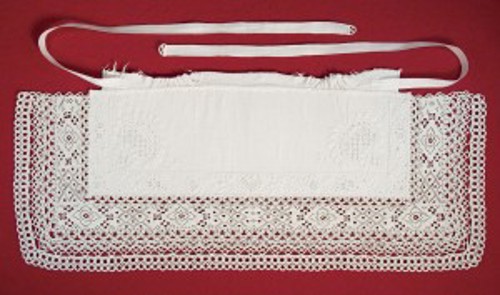Baldyring
Here on this page, you will find examples of textiles that incorporate the "baldyring" embroidery technique.

Decorative towel with "baldyring", "hvidsøm", square cut work
The decorative towel shows a rare mixture of the variations in square cut work: ”Hvidsøm”, and ”Baldyring” . The embroidery, filled with interesting details, spreads over a large part of the middle section. It is divided into five borders separated by ten rows of H hemstitching. The borders above and below the border with the monogram, contain ”Hvidsøm” fillings and ”Baldyring” fillings, as well as square cut work. All of it is surrounded by vines, with leaves sewn in outline stitch and satin stitch. The decorative towel consists of four parts. The embroidered part has been lengthened, both at the top and the bottom, by a piece of plain material. A piece of linen with a plaited warp has also been attached to the bottom.
Please note
- Inside the vase in the middle of the bottom border, a relatively rare ”Hvidsøm” filling: needle weaving including cross bars of threads
- The monogram sewn into the border with plain square cut work The monogram itself resembles drawn thread work
- The tulips in all the wide borders




Shirt with ”Baldyring” on the collar, shoulders and cuffs.
The shoulder piece is sewn with ”Baldyring” on a separate piece of fabric, which is attached to the shirt later and ends neatly at the neck. The pattern consists of flowers, vines and leaves around ”Baldyring” fillings, and stiletto holes, symmetrically lined up in the middle of the collar and cuffs. The cuffs are decorated with a narrow Hedebo edge, consisting of several rows of scallops with beading loops and picots.
Please note
- The pleats at the top of the shoulder are kept in place by back stitching and knots
- The embroidered button placed on the collar. It consists of a ring embroidered with Danish buttonhole stitch. In the middle is the classic cross used to attach the button to the clothes
- The embroidery stands out clearly, even though it is a perforated ”Baldyring” filling lined with fabric
- The embroidery on the collar is placed on the top side, which suggests that the collar is not designed to be turned up but to fold over the waistcoat and jumper





Decorative towel with cut work Hedebo and ”Baldyring”
The two variations interact nicely. The embroidery is sewn in a wide border at the top and a narrow border at the bottom. The top border is divided into several borders by H hemstitch and four-sided hemstitch. The two narrow borders have a row of tulip-like flowers embroidered in cut work Hedebo. ”Baldyring” dominates the lower border, but cut work Hedebo is a part of the leaves, which are placed in the outermost corners. A bought fringe is attached to the lowest part of the decorative towel. The monogram refers to Maren Andersdatter, born in 1834 in Karlslunde.
Bemærk
- The relationship and the contrast between ”Baldyring” and cut work Hedebo
- How the two identical tulip borders are filled with stiletto holes and cut spaces with a cross bar of threads
- The Hedebo rings with needle lace in the cut leaves around the rosettes under the initials, and in the two tulips in the corners
- The effect of the fine beading loops in the thick marguerite-like flower in the lowest border

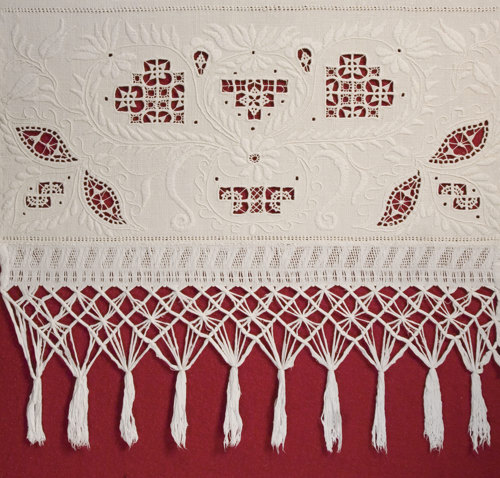
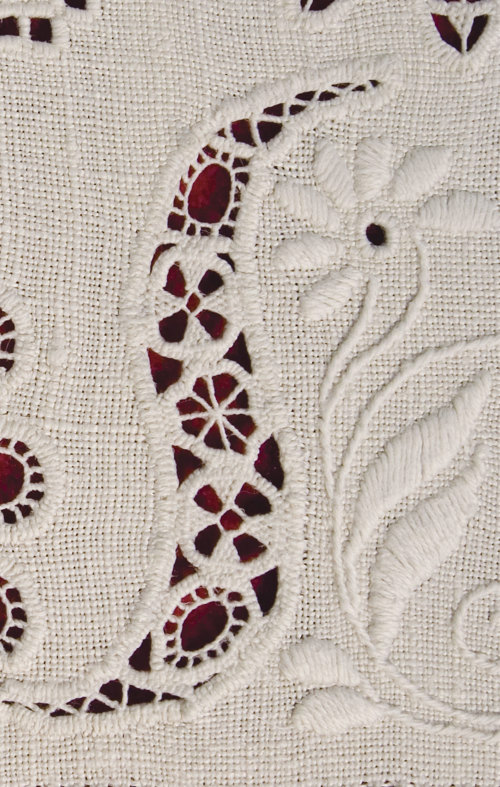

Decorative towel with ”Baldyring”
This very varied ”Baldyring” stitching extends into three borders over, and three borders under, the entwined initials, and a wide border at the bottom. The original owner of the decorative towel is likely to have been Kirsten Jens Datter (KID), who was born in 1817 in Tune, and married there around 1847, when ”Baldyring” was at its climax. We do not know if Kirsten actually did the embroidery. We are talking about a very practised and skilful needlewoman here. It is pieces such as this which inspired the architects Thorvald Bindesbøll, Anton Rosen, and Martin Nyrop to produce their later designs in Hedebo embroidery.
Please note
- The many different kinds of needle lace in the ”Baldyring” fillings
- The many different ways in which the whole or half marguerite-like flowers are embroidered
- How the traditional cross-stitch letters form the base for the monogram in stiletto holes
- That “J” is “I” in the monogram
- The widespread use of stiletto holes in vines with flowers and leaves





"Knædug" with "baldyring", square cut work, counted thread work and "hvidsøm"
The satin stitch bases are evenly spread over the canvas and bordered with tendrils and leaves in flat stitch. The fillings in the satin stitch bases are simple, consisting primarily of arches, points, and openwork. At the top, remnants of the monogram AADD can be glimpsed. The two leaves above the initials, unlike the rest of the embroidery, are filled with a whitework base. Below, before the warp plaiting, a border with square-cut embroidery featuring deer and stylized trees of life is visible.
Please note
- Two of the square bases in the top border and four in the bottom border are embroidered with cutwork Hedebo.
- The bottom border, with square-cut embroidery, H-hole stitches, and warp plaiting, is of a different fabric quality.
- The embroidered tendrils and leaves are executed with great embroidery skill, whereas many of the satin stitch bases lack this level of expertise.
- The area with the monogram is worn thin, suggesting that old monograms may have been removed and new ones added.





Cradle sheet with ”Baldyring” and cut work Hedebo
The cradle sheet has a centre motif in ”Baldyring”, surrounded by delicate vines of flowers in outline stitch and satin stitch with stiletto holes. The same type of flower vine is used in the motifs on the sides, but here the flower is embroidered in ”reverse cut work Hedebo”. The similarity in style between the flower arrangement motif in the middle and the side motifs raises the question of whether the filling in cut work was originally a ”Baldyring” filling.
Please note
- The frayed fabric in cut work Hedebo takes the form of an eightpointed star. The empty spaces in the star are filled with Danish buttonhole stitching, alternating with Hedebo wheels with small, solid points
- The three small blanket stitch leaves on the two flowers in the furthest corners
- There are only two patterns in the ”Baldyring” filling: scallop with beading loops, and point and scallop with two points. The second pattern is designed in such a way that it forms eight-pointed stars



Collar with ”Baldyring” embroidery and a Hedebo edge
The collar may have been unpicked from a shift and seamed with a narrow hem. The embroidery consists of a large pomegranate-shaped ”Baldyring” in each corner. The squares of the ”Baldyring” are relatively small and filled with crosses and blanket stitch wheels. Between the pomegranates, a flower is embroidered in satin stitch and whip stitch, plus there are two leaf-shaped motifs with ”Hvidsøm” fillings of diagonal crossstitch, stiletto holes, and satin stitch. The needle lace consists of dense rows of Danish buttonhole stitching, and the pattern is made by the small holes in the rows.
Please note
- The three squares in the square cut work in the corner motif which help make a sharp corner
- The whipped hemstitch along the whole length of the collar’s embroidery. Traditionally, hemstitching was embroidered in horizontal lines without corners
- The innumerable picots on the edge of the scallops finishing the collar
- That the collar might have changed during the process, as the lace, apparently, was taken from another collar and attached to this with long overcast stitching as seen on the reverse side



Collar with "baldyring" and Hedebo Cutwork
The collar was originally attached to a chemise and has been cut to improve the fit. It is a fine example of an embroidered collar, showcasing a wide variety in filling the squares’ open spaces. The two square fields in the corners of the innermost border feature lace stitching, similar to the cutwork technique known from Hedebo embroidery.
Please note
- The four-petal flowers in the inner embroidery, near the fabric, consist of four points where buttonhole stitches meet at the center
- Many of the openings are filled with circles created by thread tension and circles anchored at four points. Both types of circles are stitched around an openwork frame with varying numbers of stitches
- The lace stitching along the edge consists of rosettes with a Hedebo ring in the center. The rosettes are joined together and attached to the collar, possibly at a later time
- The collar was used for folk dancing around 1900 by a daughter from one of the large Hedebo farms in Greve. She may have updated an older collar

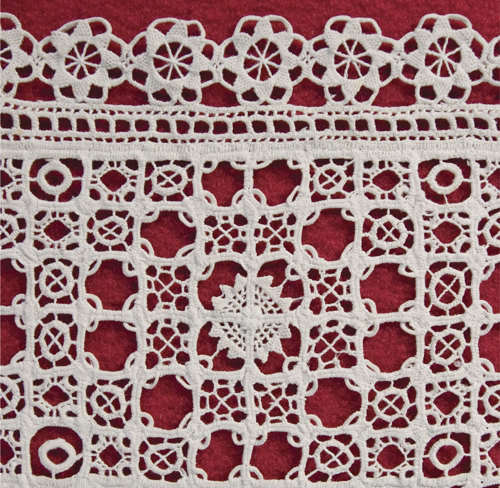
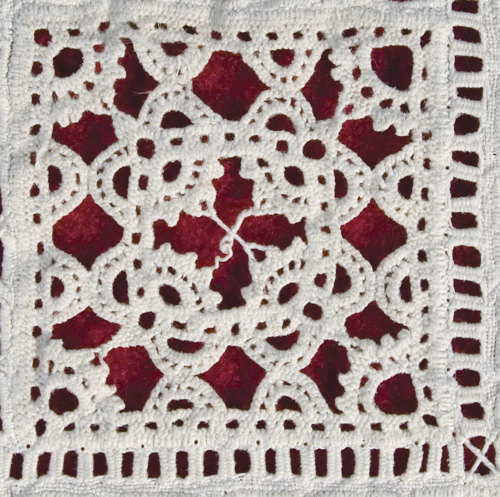
Collar with ”Baldyring”
The collar was unpicked from a shirt and was cut so that it fitted better around the neck. The ”Baldyring” ’s net is characterised by large square spaces filled with needle lace. There are woven ‘columns’ over the remaining treads between the spaces, thus making it look like double rows. The ”Baldyring” has this in common with e.g. Norwegian Hardanger needle lace, and double cut work from Amager. The collar is embroidered with needle lace on the edges.
Please note
- The ”Baldyring” pattern is created by squares filled in four different ways: squares with an open scallop, squares with open beading loops, squares with a triangle of Danish buttonhole stitching, and squares with a large point on top of the beading loops
- The embroidered needle lace work consists of 26 half circles, each made of rings with one point inside, and held together with beading loops
- The corner of the needle lace is made of five instead of four rings
- How neatly the scallops on the edge of the embroidery make the change from ”Baldyring” to needle lace


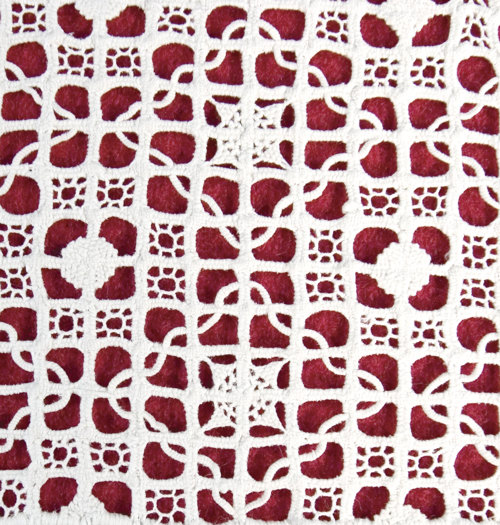
Cut off collar embroidered with ”Baldyring” and surrounded with a Hedebo edge
The pattern on the two layers of fabric consists of a pomegranate in each corner and a narrow, tightly stitched border. A number of stiletto holes can be seen both alongside the vines and in the centre of the flowers, and also in the corner motifs on the narrow border. Between the two borders is “the chain” of hemstitch. The Hedebo edge consists of both a solid and an open part. In the solid part, rows of Danish buttonhole stitch alternate with larger and smaller square spaces. The open part of the lace contains a row of Hedebo rings. This may mean the collar is either a late ”Baldyring”, or that the collar’s open part was added later when larger collars became fashionable in the middle of the 19th century.
Please note
- The chainstitch flowers in the large corner motif and around the ”Baldyring” fillings
- That the square spaces in the narrow border are filled with a cross bar of threads which is repeated in the solid part of the lace
- The small scallops at the end of the binding ribbons
- The tight row of picots finishing the small scallops
